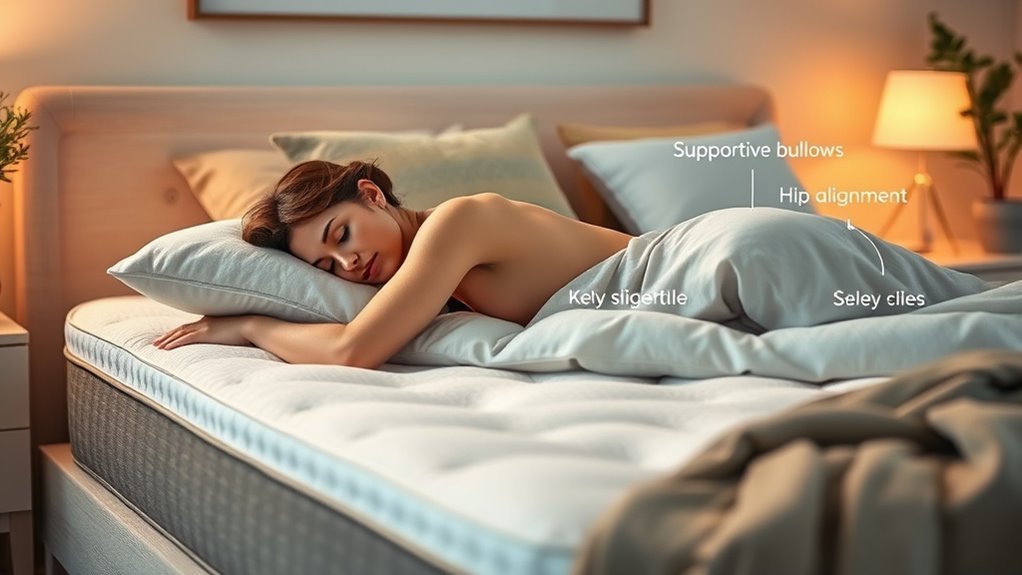If your mattress is causing hip pain as a side sleeper, start by evaluating its firmness and material. A mattress that’s too firm might create pressure points, worsening discomfort. Adding a memory foam topper can improve cushioning and support. Explore different bedding materials, as options like latex or hybrids can enhance comfort. If wear is evident, consider professional repair or replacement. There are tailored solutions to ease your discomfort, waiting just beyond this advice.
Assess Your Current Mattress Type
Before you can effectively address hip pain, it’s vital to evaluate your current mattress type, as it plays a significant role in your overall sleep quality. Start by examining the mattress firmness; it should provide adequate support while allowing your hips to sink slightly, promoting spinal alignment. If it’s too firm, you might experience pressure points, exacerbating your pain. Next, consider the material type. Memory foam tends to contour to your body, relieving pressure, while innerspring mattresses may not offer sufficient cushioning for side sleepers. A mattress that balances firmness and material can make a world of difference in your comfort. By understanding these aspects, you’re taking an important step toward reclaiming restful nights and alleviating hip pain.
Use a Mattress Topper for Added Comfort
If you’re struggling with hip pain, adding a mattress topper can be a simple yet effective solution to enhance your sleep experience. A good topper provides an extra layer of cushioning, helping to alleviate pressure points that may be causing discomfort.
Consider these options when selecting a mattress topper:When choosing a mattress topper, explore options like memory foam, cooling gel, and thickness to find your perfect fit.
- Memory foam: Conforms to your body shape, offering personalized support and reducing strain on your hips.
- Cooling gel: Regulates temperature, ensuring you stay comfortable throughout the night without overheating.
- Thickness choice: Opt for a thicker topper for more cushioning or a thinner one for a subtle adjustment.
Adjust Your Sleeping Position
Adjusting your sleeping position can greatly impact your hip pain. By optimizing your pillow height, aligning your spine properly, and experimenting with leg positioning, you can find a more comfortable way to sleep. It’s crucial to listen to your body and make these adjustments to support your hips effectively.
Optimize Pillow Height
While you might not realize it, the height of your pillow can substantially impact your hip pain during sleep. The right pillow thickness complements your sleep position, ensuring your neck and spine are aligned. If your pillow’s too high or too low, it can create unnecessary strain, exacerbating discomfort in your hips.
Consider these factors when optimizing your pillow height:
- Shoulder width: A wider shoulder may require a thicker pillow to maintain alignment.
- Neck curvature: A pillow that supports the natural curve of your neck can alleviate pressure.
- Personal comfort: Experiment with different pillow types, like memory foam or down, to find what works best for you.
Finding the right balance can help you sleep more soundly and free from pain.
Align Spine Properly
To alleviate hip pain during sleep, it’s essential to align your spine properly by considering your sleeping position. When you sleep on your side, maintaining proper spinal alignment can greatly reduce discomfort. Make sure your mattress firmness supports your body without causing your hips to sink too deeply. A mattress that’s too soft may lead to poor alignment, while one that’s too firm can create pressure points. Experiment with positioning your body—keeping your knees slightly bent can help maintain natural curvature. Additionally, using a supportive pillow can further enhance alignment. By making these adjustments, you can create a more comfortable sleeping environment that promotes freedom from pain and supports restorative rest.
Experiment With Leg Position
Have you considered how your leg position might impact your hip pain while sleeping? Your leg alignment plays an essential role in maintaining proper hip alignment, especially for side sleepers. Experimenting with different leg positions can help alleviate discomfort and promote better rest.
Try these adjustments:
- Place a pillow between your knees to reduce strain on your hips.
- Bend your knees slightly to a more relaxed angle, allowing for better support.
- Stretch your legs straight, but make sure your hips remain aligned with your spine.
Experiment With Pillow Placement
Finding the right pillow placement can make a significant difference in alleviating hip pain during sleep. Experimenting with various pillow types can help you discover what feels best for your body. For instance, placing a thin pillow between your knees might align your hips better, reducing strain. Alternatively, consider a firmer pillow under your head for proper neck support, which can indirectly ease hip discomfort. Try different placement strategies, like adjusting the height of the pillow or using multiple pillows to see what works best for you. Remember, everyone’s body is unique, so don’t hesitate to make adjustments until you find that sweet spot. Your comfort and freedom during sleep should always be your priority.
Explore Different Bedding Materials
Choosing the right bedding materials can greatly impact your comfort and help alleviate hip pain during sleep. When selecting materials, consider how they conform to your body and offer support.
- Memory foam: This material molds to your shape, providing targeted support for your hips and relieving pressure points.
- Latex benefits: Known for its durability and responsiveness, latex allows for better airflow and keeps you cool while offering a bouncy support that can align your spine.
- Hybrid options: Combining both memory foam and latex can give you the best of both worlds, balancing contouring comfort and resilient support.
Maintain Proper Mattress Hygiene
Even with the right bedding materials, maintaining proper mattress hygiene plays a significant role in your overall sleep quality and comfort. Regular mattress cleaning is essential to keep dust mites and allergens at bay, which can contribute to hip pain and discomfort. Consider vacuuming your mattress monthly, using a vacuum with a HEPA filter to trap those pesky dust mites. Also, invest in a mattress protector to shield against spills and stains. Wash your bedding weekly in hot water to further enhance dust mite prevention. By prioritizing cleanliness, you’re not just prolonging your mattress’s life; you’re also creating a healthier sleep environment that allows you to wake up refreshed and free from pain. Your body will thank you!
Consider Professional Mattress Repair or Replacement
If your mattress is causing hip pain, it might be time to contemplate professional repair or replacement. Repairing worn areas can extend the life of your mattress, but sometimes a full replacement is the better option. A professional assessment can help you understand the best route to take for your comfort and health.
Repairing Worn Areas
As you notice the telltale signs of wear on your mattress, such as sagging or lumps, it’s crucial to assess whether a professional repair or complete replacement is the best course of action. The choice often depends on the type of mattress materials and the specific wear patterns.
Consider these options for repairing worn areas:
- Reinforcement: Adding extra support to sagging sections.
- Patching: Using specialized materials to cover lumps and indentations.
- Restoration: Hiring professionals who can restore the original feel.
While repair can extend your mattress’s life, sometimes the effort isn’t worth it. Weigh your options carefully, as a well-rested night is key to your freedom and well-being.
Replacement Options Available
When it comes to addressing hip pain caused by your mattress, weighing your replacement options is essential. You’ve got several mattress brands to evaluate, each offering different materials and levels of support. Look for those designed specifically for side sleepers, as they often feature enhanced pressure relief. Budget considerations play a significant role too; you want to balance cost with quality. High-end models can be tempting, but there are plenty of affordable options that still provide excellent support. Remember, investing in a mattress that aligns with your comfort needs can lead to better sleep and overall well-being. Take your time to research and find the right fit that doesn’t just meet your budget but also liberates you from hip pain.
Professional Assessment Benefits
While you might consider tackling mattress issues on your own, seeking a professional assessment can provide invaluable insight into whether repair or replacement is the better route for alleviating your hip pain. A thorough mattress evaluation by an expert can uncover hidden problems and offer tailored solutions. Here are some benefits you might experience:
- Expert consultation to identify specific support needs
- Accurate diagnosis of wear and tear that you may overlook
- Guidance on materials that suit your sleeping style
Ultimately, investing in professional advice can pave the way to a more restful night’s sleep, freeing you from discomfort and allowing you to regain the freedom to enjoy restorative rest.
Frequently Asked Questions
How Long Should I Keep My Mattress Before Replacing It?
You should consider replacing your mattress every 7 to 10 years, as that’s its typical lifespan. However, if you notice signs like sagging, discomfort, or persistent aches, it might be time for a new one sooner. Trust your body; it knows best when something isn’t right. Prioritizing your sleep quality can lead to a healthier, more energetic life, giving you the freedom to embrace each day without discomfort.
Can a Mattress Cause Long-Term Hip Problems?
Yes, a mattress can lead to long-term hip problems if it doesn’t support proper hip alignment. Poor-quality mattress materials or unsuitable firmness can cause your hips to sink too deeply or not enough, resulting in misalignment. This strain may contribute to chronic pain over time. It’s essential to choose a mattress that maintains your spine’s natural curve and supports your hips adequately, ensuring a restful and pain-free night’s sleep.
What Firmness Level Is Best for Side Sleepers?
Oh sure, you could sleep on a rock and call it “nature’s firmness,” but let’s be real: side sleepers like you need a medium to medium-soft mattress. This type cradles your hips and shoulders, aligning your spine while you dream of freedom from that pesky pain. Memory foam or latex mattresses are often ideal choices, offering support without sacrificing comfort. So, embrace the softness; your hips will thank you!
Are There Specific Brands Recommended for Hip Pain Relief?
If you’re seeking specific brands for hip pain relief, consider memory foam or latex mattresses, as they often provide excellent support for side sleepers. Brands like Tempur-Pedic and Saatva are well-regarded for their pressure-relieving properties. Additionally, Purple mattresses offer unique support due to their hyper-elastic polymer grid. Ultimately, it’s essential to test different mattress types to find one that aligns with your sleep position and personal comfort needs.
How Can I Tell if My Mattress Is Sagging?
To tell if your mattress is sagging, start with a thorough mattress inspection. Look for visible dips or indentations, especially where you typically sleep. You might notice uneven surfaces or feel pressure points when lying down. Additionally, check if your spine aligns properly; if not, it’s a sign of sagging. Remember, a mattress losing its shape can impact your sleep quality, so recognizing the signs early is key to maintaining your freedom in restful sleep.



